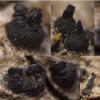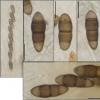
30-12-2025 16:44
Pascal DucosBonjour,Une anamorphe rose stipitée, très nombre

30-12-2025 17:14
 Bernard CLESSE
Bernard CLESSE
Bonjour à toutes et tous,Pourriez-vous aider Albe

29-12-2025 10:15
Hulda Caroline HolteHello, I found and collected this propoloid ascom

30-12-2025 09:04
Hello.A Pyrenomycete sprouting sparsely but very d

29-12-2025 17:44
Isabelle CharissouBonjour,J'aimerais savoir si d'autres personnes au

12-11-2021 00:03
Lepista ZacariasHi everybody,A week ago in my fiels trip I noticed

29-12-2025 17:12
 Bernard CLESSE
Bernard CLESSE
Bonjour à toutes et tous,Pourriez-vous m'aider à
Lophiostomataceae
Gernot Friebes,
16-03-2010 21:10
here I have a second indeterminate pyreno which grew on the bark of a living Fraxinus. The ascomata are very conspicuous because they can be from Navicella-like with a small, slit-shaped neck to even Ceratostomella-like with a long and thin neck (I checked that they really are of the same species). The spores are 22,5-25 x 8-9 µm, mature always 4-celled and slightly rough, often with two paler end-cells. The asci are bitunicate and 8-spored. I didn't find a species within the Lophiostomataceae which would fit with my species.
Best wishes and many thanks,
Gernot
Christian Lechat,
16-03-2010 21:16

Re:Lophiostomataceae
Hi, Gernot,
I think your fungus is maybe Lophiostoma maculans H. Fabre
All the best,
Christian
I think your fungus is maybe Lophiostoma maculans H. Fabre
All the best,
Christian
Gernot Friebes,
16-03-2010 22:18
Re:Lophiostomataceae
Hi Christian,
thank you very much! The photos of your find and the description by Saccardo fit quite well. It seems to be a rare species, at least there is apparently not much literature on it. Even google provides only few hits.
Best wishes,
Gernot
thank you very much! The photos of your find and the description by Saccardo fit quite well. It seems to be a rare species, at least there is apparently not much literature on it. Even google provides only few hits.
Best wishes,
Gernot




